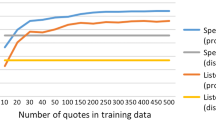Abstract
We propose a multi-modal dialogue analysis method for medical interviews that hierarchically interprets nonverbal interaction patterns in a bottom-up manner and simultaneously visualizes the topic structure. Our method aims to provide physicians with the clues generally overlooked by conventional dialogue analysis to form a cycle of dialogue practice and analysis. We introduce a motif and a pattern cluster in the designs of the hierarchical indices of interaction and exploit the Jensen–Shannon divergence (JSD) metric to reduce the number of usable indices. We applied the proposed interpretation method of interaction patterns to develop a corpus of interviews. The results of a summary reading experiment confirmed the validity of the developed indices. Finally, we discussed the integrated analysis of the topic structure and a nonverbal summary.








Similar content being viewed by others
References
Greenhalgh T et al (1998) Narrative based medicine: dialogue and discourse in clinical practice. BMJ Books, London
Roter D et al (2002) The Roter interaction analysis system (RIAS). Patient Educ Couns 46:243–251
Mase K, Sumi Y, Toriyama T, Tsuchikawa M, Ito S, Iwasawa S, Koguure K, Hagita N (2006) Ubiquitous experience media. IEEE Multimedia, Oct–Dec, pp 20–29
Koyama Y, Hirano Y, Kajita S, Mase K, Katsuyama K, Yamauchi K (2006) Doctor-patient communication supporting method by visualizing topic structure, CSCW2006 Conference Supplement, pp 195–196
Lin J, Keogh E, Lonardi S, Patel P (2002) Finding motifs in time series. In: The 2nd workshop on Temporal data mining, the 8th ACM international conference on knowledge discovery and data mining, pp 23–26
Fuglede B, Topsoe F (2004) Jensen-Shannon divergence and Hilbert space embedding. In: Proceedings the international symposium on information theory, pp 31–36
Wren CR, Ivanov YA, Kaur I, Leigh D, Westhues J (2007) Social motion: measuring the hidden social life of a building, location- and context-awareness 2007. Lect Notes Comput Sci 4718:85–102
Shiomi M, Kanda T, Ishiguro H, Hagita N (2007) Interactive humanoid robots for a science museum. IEEE Intell Syst 22(2):25–32
Otsuka K, Takemae Y, Yamato J, Murase H (2005) A probabilistic inference of multiparty-conversation structure based on Markov-Switching models of gaze patterns, head directions, and utterances. In: Proceedings of the ACM international conference on multimodal interfaces (ICMI)’ 05, pp 191–198
Otsuka K, Sawada H, Yamato J (2007) Automatic inference of cross-modal nonverbal interactions in multiparty conversations. Proc ICMI 2007:255–262
Zhiwen Yu, Zhiyong Yu, Yusa Ko, Xingshe Zhou, Yuichi Nakamura (2009) Inferring human interactions in meetings: a multimodal approach. In: The 6th international conference on ubiquitous intelligence and computing (UIC 2009), pp 14–24, July 7–9, Brisbane, Australia
Hillard D, Ostendorf M, Shriberg E (2003) Detection of Agreement vs. Disagreement in Meetings: Training with Unlabeled Data. Proc HLT-NAACL 2003:34–36
Tomobe H, Nagao K (2006) Discussion ontology: knowledge discovery from human activities in meetings. Proc Jpn Soc Artif Intell (JSAI) 2006:33–41
Ong LML, de Haes JCJM, Hoos AM, Lammes FB (1995) Doctor-patient communication: a review of the literature. Soc Sci Med 40(7):903–918
Gorawara-Bhat R et al (2007) Nonverbal communication in doctor elderly patient transactions (NDEPT): development of a tool. Patient Educ Couns 66:223–234
Dent E et al (2005) The Cancode interaction analysis system in the oncological setting: reliability and validity of video and audio tape coding. Patient Educ Couns 56:35–44
Schmid Mast M (2007) On the importance of nonverbal communication in the physician-patient interaction. Patient Educ Couns 67:315–318
Morita T, Hirano Y, Sumi Y, Kajita S, Mase K (2005) A pattern mining method for interpretation of interaction. In: Proceedings on international conference on multimodal interface (ICMI’05), pp 267–273
Kullback S, Leibler RA (1951) On information and sufficiency. Ann Math Stat 22(1):79–86
Saito S et al. (2003) Practice of narrative based medicine. Kongo Shuppan (in Japanese)
Katsuyama K, Koyama Y, Hirano Y, Mase K, Kato K, Mizuno S, Yamauchi K (2009) Computer analysis system of the physician-patient consultation process. Int J Health Care Quality Assurance 23(4)
Connor M et al (2009) The analysis of verbal interaction sequences in dyadic clinical communication: a review of methods. Patient Educ Couns 75(2):169–177
Pinhanez C, Mase K, Bobick A (1997) Interval scripts: a design paradigm for story-based interactive systems. In: CHI97 Conference Proceedings, pp 287–294
Acknowledgments
This research was supported by a Grant-in-Aid for Scientific Research (18300048).
Author information
Authors and Affiliations
Corresponding author
Appendix
Appendix
1.1 Motif occurrence
The normalized expected occurrence of motif Mot = (Pat1,…,Pat n ), assuming that all patterns are independent of each other, is as follows:
where P(Pat i ) = P i , \( 1 - P_{i} = \overline{{P_{i} }} \). \( P^{\prime}_{d} \left( {\text{Mot}} \right) \) is given as motif occurrence \( P_{d} \left( {\text{Mot}} \right) \) divided by L(Mot):
1.2 Pattern co-occurrence measure
When motif MOT ij contains consecutive patterns Pat i and Pat j as its elements, as \( {\text{MOT}} \supseteq {\text{MOT}}_{ij} = \left\{ {{\text{Mot}} = \left( { \ldots ,P_{i} ,P_{j} , \ldots } \right)} \right\}, \) we can compute pattern co-occurrence measure \( {\text{Cooc}}\left( {} \right) \) between patterns Pat n and Pat m :
Rights and permissions
About this article
Cite this article
Koyama, Y., Sawamoto, Y., Hirano, Y. et al. A multi-modal dialogue analysis method for medical interviews based on design of interaction corpus. Pers Ubiquit Comput 14, 767–778 (2010). https://doi.org/10.1007/s00779-010-0289-5
Received:
Accepted:
Published:
Issue Date:
DOI: https://doi.org/10.1007/s00779-010-0289-5




